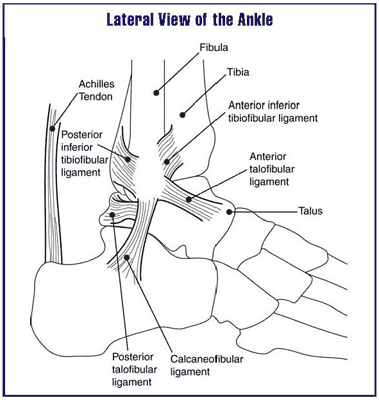Common Ankle Sprains

Recovery from an Ankle Sprain
Most people have “twisted” their ankle at some point. It may have been caused by a common activity like playing sports, working or just walking down the street. A twisted or sprained ankle is painful and can limit a person’s function for a long time. It is not uncommon for these injuries to take several months to heal completely. Physical Therapy can help to speed up the healing process and restore normal function of the injured ankle.
The Basics of a Sprained Ankle
Understanding a sprained ankle begins by understanding the foot and ankle as a complex component. One part cannot function independently of the other. In fact, there are over 20 bones involved in every movement of the complex. These bones are held together statically by bands of leather- like soft tissue called ligaments, and the ankle and foot complex are “dynamically stabilized” by the surrounding musculature.
Ligaments do not stretch very much. When there is too much stress placed through them via a foot and ankle motion, the ligaments can tear. This tearing is often accompanied with an audible “cracking” sound followed immediately by the onset of pain, swelling and loss of function. When an injury occurs, the “dynamic stability” can be reduced because the muscle structure does not work as well.
The Inversion Sprain
The most common type of ankle sprain involves the ligament(s) on the lateral (outside) aspect of the ankle. This is called an inversion sprain. The Anterior (front) Talo Fibular ligament or ATF is the most commonly sprained ligament in the ankle. Due to the anatomy and the mechanics of the foot/ankle during weight bearing activities, the damaging motions and forces occur when the foot/ankle “roll” outward or laterally. The inversion sprain most commonly involves the ATF, but there are 2 other ligaments that may get injured at the same time. The stability of the joints of the foot and ankle is compromised when the ligament structure is damaged. Rarely are all 3 ligaments injured at the same time.
It is common to have swelling and bruising or a “black and blue area under the ankle bone.” If the sprain is bad enough, the bruising can extend into the toes and up the leg. There is almost always swelling around the ankle bone that can extend into the entire foot depending on the severity of the sprain. The muscles of the area will not work well and the lack of muscle strength makes the joint more susceptible to another injury. The patient usually has pain that can cause them to limp when they walk.
While the soft ligaments tissues will heal on their own, they help at an extremely slow pace. A Physical Therapist will utilize various techniques to help reduce the acute symptoms of an ankle sprain.
Treatment of an Ankle Sprain
Physical Therapy treatment can help to remove the natural inhibitors of healing and enhance the speed of recovery through a rehabilitation program specifically designed for the patient’s ankle injury. The qualified Physical Therapist will offer patients tools to strengthen and re-educate the ankle musculature. If the muscles provide adequate dynamic stability to the injured ankle, the dependence on the injured ligament is significantly less. By improving the strength of the muscles, the patient reduces the likelihood recurrent injuries.
Ankle sprains are very common in every walk of life. If treated properly, the symptoms will not hinder one’s function for a prolonged period of time. A Physical Therapist can design a rehabilitation program and provide the education of a routine that will ensure a full recovery, helping patients return to their pre-injury lifestyle.

























